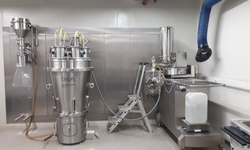Scientific papers
Despite the daily production of large quantities of tablets, many of the established processes and formulations have evolved through (suboptimal) trial-and-error experiments, leading to the perception that the pharmaceutical powder technology field is more of an "art than a science" [1]. Additionally, numerous contributions to the field date back roughly two or three decades. Although the operation mode and press layout have remained essentially unchanged since their invention, advancements in instrumentation, particularly in terms of quality, accuracy, and sensitivity, have been substantial. The pharmaceutical landscape has witnessed increased competition from generic manufacturing and a shift toward more patient-centered production, resulting in the development of advanced tablet formulations with features such as prolonged, extended, delayed, or immediate release profiles.
In alignment with the Process Analytical Technology (PAT) initiative proposed by the American Food and Drug Administration (FDA) in 2004, there is a growing impetus to transition toward a more scientifically based technology. The PAT initiative aims to encourage the pharmaceutical industry to "design and develop processes that can consistently ensure a predefined quality at the end of the manufacturing process." This involves identifying all sources of variation crucial for product performance and quality and, through increased process understanding and continuous monitoring, building quality into the product rather than testing it [2]. This initiative, coupled with the International Conference on Harmonization (ICH) Q8 guideline on Pharmaceutical Development, emphasizing the Quality-by-Design (QbD) concept, forms the regulatory framework driving the pharmaceutical industry's shift in approach [3-5].
Given these evolving dynamics within tablet manufacturing, there is a clear need for new knowledge to establish a foundation for a comprehensive understanding of the continuous tableting process. This thesis aims to contribute to this broader context by investigating the tableting process on a high-speed rotary tablet press. The objective was to enhance understanding regarding the influence of the properties of the starting material and process parameters on dependent process parameters and tablet properties. In line with the PAT initiative, which promotes the adoption of new analytical tools to improve process understanding and product quality, additional analytical chemistry tools were employed alongside the built-in instrumentation. Moreover, due to the substantial volume of data collected, Design of Experiments (DoE) and Multivariate Data Analysis (MVA) were employed to conduct experiments and analyze data in a structured manner. The three main topics addressed in this investigation were:
1. The role of the forced feeder: its impact on the properties of the starting material, the die-filling process, and the final tablet properties.
2. The mechanism of (double) compression: its influence on dependent process parameters and the final tablet properties.
3. The role of additional analytical chemistry tools in a continuous tableting process: their applicability in assessing tablet properties produced from starting material with different characteristics.
Comments
No comments posted yet.
Add a comment














